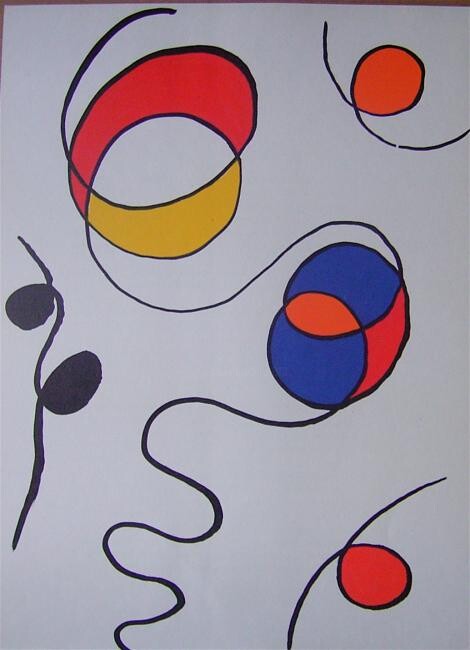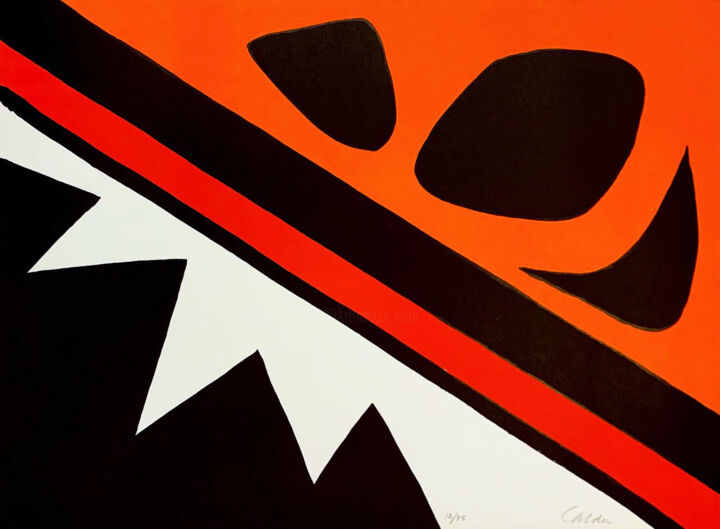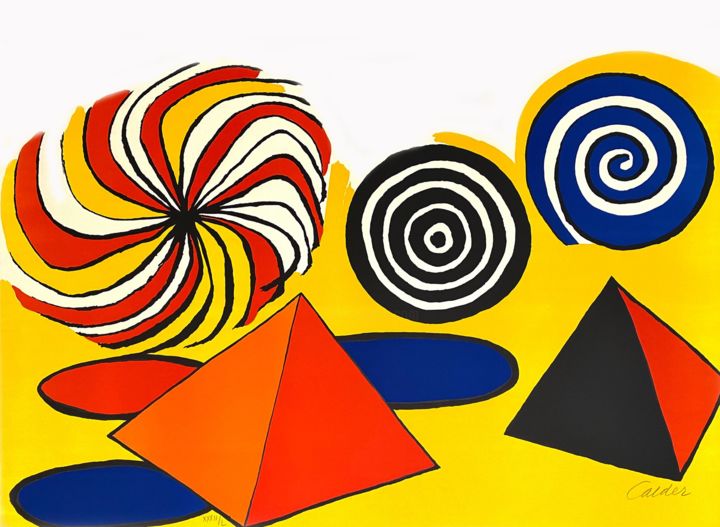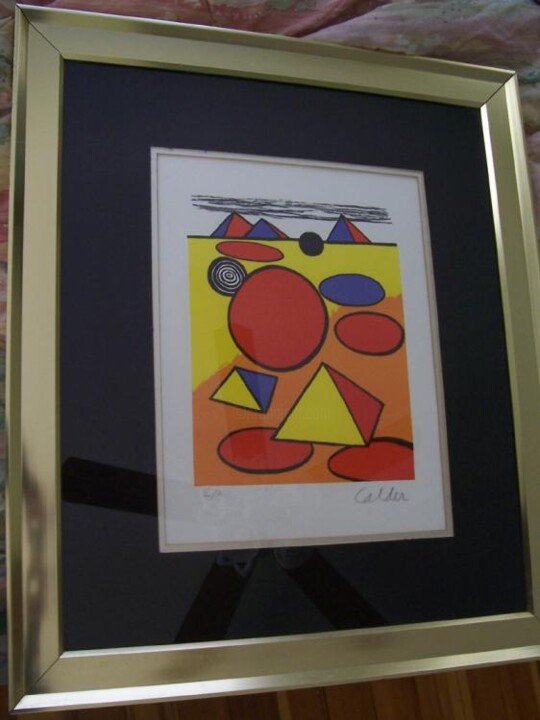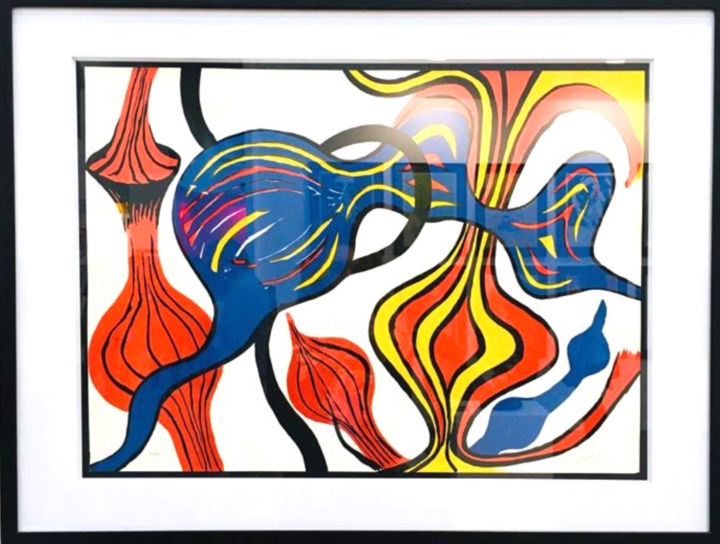 Alexander Calder, credit: Josepclopesbosc via Wikipedia
Alexander Calder, credit: Josepclopesbosc via Wikipedia
Alexander Calder, born July 22, 1898 in Lawnton, Pennsylvania, and died November 11, 1976 in New York, is an iconic figure of modern art, world-renowned for his innovative kinetic sculptures called "mobiles". American artist with a career exceptional, Calder revolutionized the world of sculpture by integrating movement and interaction with the environment. His unique approach, combining mechanical engineering and artistic sensitivity, gave birth to dynamic and poetic works that continue to inspire and to influence generations of contemporary artists. In this article, we will explore the life and work of Alexander Calder, highlighting his lasting impact on 20th-century art.
Beginnings and Training
Born into a family of renowned artists, Alexander Calder was born on July 22, 1898, in Lawnton, Pennsylvania. His father, Alexander Stirling Calder, was a renowned sculptor, and his mother, Nanette Lederer Calder, was a talented painter. This creative atmosphere permeates his childhood and deeply influences his artistic development. From a very young age, he is immersed in the world of arts, thus shaping his future path.
Before devoting himself entirely to his destiny, he trained in mechanical engineering at the Stevens Institute of Technology. This technical education played a crucial role in his ability to design innovative and complex creations. In 1923, he enrolled at the Art Students League of New York, where he refined his artistic skills and explored various techniques. This unique combination of engineering and art skills became his trademark, allowing him to create dynamic and balanced works.
Calder's early works reflect his interest in animation and mechanics. In 1926, he moved to Paris and began experimenting with wire sculptures, resulting in light, moving creations. It was during It was during this period that he discovered his true passion for kinetic sculpture, a form of creation that incorporates real movement. His creations, often inspired by themes from nature and everyday life, are distinguished by their technical innovation and aesthetics. unique.
Mobiles: Art in Motion
 Alexander Calder, Red Mobile (1956), Montreal Museum of Fine Arts, credit: Montrealais via Wikipedia
Alexander Calder, Red Mobile (1956), Montreal Museum of Fine Arts, credit: Montrealais via Wikipedia
"Mobiles" are suspended kinetic sculptures that are distinguished by their ability to move thanks to air currents. Invented by Alexander Calder, they integrate elements in delicate balance, creating a harmonious dance of shapes and colors. They are recognized for their lightness and fluidity, transforming space into a dynamic visual experience.
Their creation relies on the use of materials such as metal and wire. They are carefully designed to be perfectly balanced, allowing each part to move independently. Technical precision is essential, with each element adjusted to maintain a delicate balance while allowing maximum freedom of movement. This combination of technique and art gives rise to creations that seem almost alive.
Movement is at the heart of mobiles, making interaction with the environment a crucial element. They react to air currents, constantly changing their shape and visual composition. Light also plays an important role, casting shifting shadows and adding an extra dimension to the work. This interaction with the environment makes them unique pieces, each installation offering a new visual and sensory experience.
The Stabiles and Monumental Works
 Alexander Calder, Chicago Loop, Chicago, credit: Roman Kharkovsky via Wikipedia
Alexander Calder, Chicago Loop, Chicago, credit: Roman Kharkovsky via Wikipedia
The "stabiles" are static sculptures, created by Alexander Calder, which are distinguished from the "mobiles" by their lack of movement. While the mobiles are suspended and move with the air currents, the stabiles are anchored to the ground, imposing their presence through their form and structure. These works, often large-scale, express the same artistic sensibility but through fixed and monumental compositions.
Among the most famous works are "The Spiral" , created for the 1958 World's Fair in Brussels, and "The Man" , made for the 1967 World's Fair in Montreal. "The Spiral" is a creation in impressive steel, which embodies dynamism with its twisted form. "The Man" is another colossal achievement, representing a stylized human being, marking the horizon with its imposing stature and complex structure.
They were often commissioned for public spaces, integrating art into urban planning in a spectacular way. These monumental structures are designed to interact with their surroundings, transforming public squares, parks and buildings into open-air galleries. Their His commanding presence in places such as Chicago, Paris, and other major cities around the world is a testament to the artist's lasting impact on the urban landscape. Public commissions have helped bring contemporary art to the heart of spaces daily, inviting the public to constant contemplation and interaction with art.
Artistic Diversity and Collaborations
Beyond his iconic sculptures, Alexander Calder explored a variety of other media. He excelled in painting, drawing, and jewelry design. His paintings and drawings often reflect the same dynamism as his sculptures, using abstract shapes and bright colors. His jewelry, meanwhile, is sculptural miniatures, mixing metal and precious stones, combining elegance and innovation.
Calder also collaborated with many artists and influential figures of his time. These collaborations enriched his work and broadened his artistic horizons. For example, his friendship with Joan Miró inspired creative exchanges, each influencing the work of the other. Likewise, his interactions with architects, musicians and writers have allowed for a fusion of disciplines, giving birth to multidimensional and inspiring works.
Interdisciplinary projects were an important part of Calder's career. He was asked to undertake special commissions, integrating his creations into a variety of environments.
Theatre Sets : Calder designed sets and costumes for theatre productions, including the famous play "Marcel Duchamp's Dream" in 1945. His theatrical designs, using abstract shapes and bright colours, brought a new visual dimension to the productions. scenic.
Tapestries : Collaborating with weaving workshops, Calder created monumental tapestries. These textile creations, often inspired by his paintings and drawings, combine abstract patterns and vibrant colors, adding a unique texture and depth to interior spaces.
International exhibitions : For the 1937 Universal Exhibition in Paris, he designed the "Mercury Fountain", a kinetic work in metal.
Public commissions : He completed "Flamingo" (1973) for the Federal Plaza in Chicago, a work in bright red steel that stands out for its grandeur and its interaction with the surrounding architecture.
Impact and Legacy
Calder's impact on contemporary art is undeniable. His innovative approach to kinetic sculpture paved the way for many modern and contemporary artists. The dynamic, interactive works he created have inspired generations of artists to explore movement, balance and interaction with the environment in their own creations. Calder's ability to fuse art and science also encouraged increased interdisciplinarity in the arts, influencing fields such as architecture, design and art installations.
Calder's works are included in the collections of the world's greatest museums. Prestigious institutions such as the Museum of Modern Art (MoMA) in New York, the Centre Pompidou in Paris, and the Tate Modern in London house major pieces of his work. repertoire. It has been the subject of numerous retrospectives in many museums.
Retrospective exhibitions dedicated to Calder are frequent, revisiting and celebrating his prolific work. Exhibitions such as "Calder: Hypermobility" at the Whitney Museum of American Art and "Calder and Abstraction" at the Los Angeles County Museum of Art have highlighted spotlight the innovation and diversity of his creations. In addition, regular commemorations mark the anniversaries of his birth and death, recalling his lasting impact on the art world. These events attract not only art connoisseurs , but also a wider audience, helping to perpetuate Calder's legacy.
Analysis and Criticism
Major Works of Alexander Calder
Lobster Trap and Fish Tail (1939)"Lobster Trap and Fish Tail" is one of Calder's early mobiles, installed at the Museum of Modern Art (MoMA) in New York. This suspended creation combines abstract forms reminiscent of lobster traps and fish tails, creating a captivating aerial ballet.
Arc of Petals (1941)
"Arc of Petals" is another iconic kinetic composition, depicting a series of colorful, organic shapes suspended in delicate balance. This mobile is on display at the National Gallery of Art in Washington DC.
The Spiral (1958)
Created for the Universal Exhibition in Brussels, "La Spirale" is a monumental metal ensemble. This fixed creation, or "stabile", has an ascending spiral shape, symbolizing dynamism and momentum towards the future.
The Man (1967)
"L'Homme" is a giant creation created for the Montreal World's Fair. This imposing work, made of stainless steel, represents a stylized human figure and stands as a symbol of strength and modernity.
 Man, sculpture by Alexander Calder (1967), in Parc Jean Drapeau, Montreal, Quebec, Canada, credit: Idej Elixe via Wikipedia
Man, sculpture by Alexander Calder (1967), in Parc Jean Drapeau, Montreal, Quebec, Canada, credit: Idej Elixe via Wikipedia
Flamingo (1973)
Installed in Chicago's Federal Plaza, "Flamingo" is a bright red steel ensemble. This stabile, with its elegant curves and fluid lines, contrasts with the surrounding rigid architecture, adding a touch of poetry to the urban space.
Mercury Fountain (1937)
"Mercury Fountain" was created for the Universal Exhibition in Paris and is currently on display at the Fundació Joan Miró in Barcelona. This kinetic fountain uses liquid mercury, creating hypnotic movements and reflecting light in spectacular ways.
Calder Circus (1926-1931)
"Cirque Calder" is an interactive, miniature creation of a moving circus. Made of wire, fabric, and other materials, this creation showcases Calder's ingenuity and humor, and is housed in the Whitney Museum of American Art in New York.
Three Discs, One Lacking (1968)
Installed at the Fondation Maeght in France, this monumental ensemble is an example of Calder's exploration of geometric forms and balance. The three discs, one of which is incomplete, create an intriguing and dynamic composition.
22 Squares (1952)
"22 Squares" is a wood and painted metal mobile featuring a series of colorful hanging squares. This creation, on display at the Philadelphia Museum of Art, illustrates Calder's ability to transform simple shapes into visually stimulating compositions. .
Vertical Constellation with Bomb (1943)
"Vertical Constellation with Bomb" is a wood and metal work depicting a vertical constellation of suspended forms. It is on display at the San Francisco Museum of Modern Art and reflects Calder's preoccupation with the themes of war and the peace.
Works on paper
In addition to his famous sculptures, Alexander Calder also produced a significant number of works on paper, including screen prints and drawings. His screen prints, often colorful and dynamic, reflect the same principles of movement and form as his sculptures. Using printing techniques, Calder was able to experiment with abstract patterns and geometric compositions, creating works that are both visually captivating and technically innovative.
Calder's drawings, often done in ink or pencil, reveal his talent for line and contour. These works on paper display a sensitivity and spontaneity that complement his three-dimensional creations.
 Alexander Calder, Curl, Lithograph 40.6 x 30.5 cm
Alexander Calder, Curl, Lithograph 40.6 x 30.5 cm
Curls
Alexander Calder's work "Curls" is a lithograph characterized by sinuous black lines forming loops and spirals, and by the use of bright colors such as red, blue and yellow. The colorful circular shapes, distributed in a balanced manner, contrast with the black lines and create a feeling of movement and dynamism. The asymmetrical composition and the use of abstract forms are typical of Calder's style, recalling his work in sculpture and mobile, and perfectly illustrate his ability to combine simplicity of form and complexity of composition to produce visually captivating works.
 Alexander Calder, The Frog and the Saw (1969), lithograph. No. 12/75, 55.9 x 76.2 cm
Alexander Calder, The Frog and the Saw (1969), lithograph. No. 12/75, 55.9 x 76.2 cm
The Frog and the Saw
Alexander Calder's "The Frog and the Saw," created in 1969, is a vibrant lithograph characterized by bold geometric shapes and a contrasting color palette. The composition is divided into two main triangles, one black and white and the other 'other orange and black, separated by a diagonal red band. The irregular black shapes on the orange background evoke abstract patterns, while the jagged edges of the black triangle on the white background recall a saw. This dynamic work perfectly illustrates the distinctive style of Calder, combining abstraction, movement and vibrant colors to create a visually striking and energetic composition.
In his time, Calder's work was widely acclaimed by critics and the public. His exhibitions in Paris and New York and retrospectives were highly successful, and he was hailed as a pioneer of modern sculpture. Today Today, his work continues to be celebrated and studied, occupying a prominent place in museums and private collections around the world. Contemporary reevaluation of his work highlights its crucial role in the development of kinetic art and the the influence he had on contemporary and later artists.
Calder made significant contributions to sculpture and kinetic art. He revolutionized the way this type of work is perceived, introducing real movement into three-dimensional works. His technical approach, combining engineering and aesthetics, opened up new possibilities for artists, allowing them to explore the temporal dimension in their creations. In addition, his stabiles and mobiles have set standards for the integration of art into public space, making his works cultural landmarks and artistic in many cities around the world.


 Jean Dubreil
Jean Dubreil


